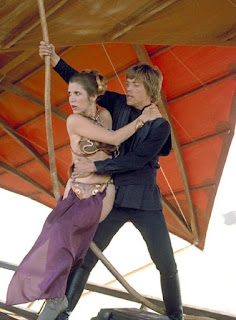By Michael Lyons
A Long Time Ago (well, about three and a half decades ago) in a Galaxy Far, Far Away (or, at least, crowded theaters), geeks throughout the universe thought that we were about to see the very last “Star Wars” film.
Today, such a thought seems like more than a nightmare to fans, who are used to getting a new “Star Wars” film once a year, or thanks to the upcoming “Solo,” every six months!
But back in the summer of 1983, we all thought that George Lucas’ “Skywalker Saga” and “Star Wars” movies in general, had come to an end with “Return of the Jedi.”
With the film’s 35th anniversary this month, what better way to celebrate “Star Wars Day” (“May the 4th Be with You!”) than to take a look back at “Return of the Jedi.”
Most are familiar with “Episode VI” and how Luke Skywalker rescues his buddy Han from Jabba the Hutt (while Princess Leia sits nearby in “that bikini!”), the Rebels travel to the planet Endor, meet the cuddly Ewoks, shut down the new Death Star and Luke faces Darth Vader for an epic lightsaber duel.
“Return of the Jedi” took criticism at the time (and to this day) for being a “glorified Muppet Movie” and pandering to the kiddie, action figure crowd. What many have missed is how skillfully the screenplay by Lucas and Lawrence Kasden balances a number of stories, while tying up loose ends and subtly expressing some significant themes.
Reigning in all of the controlled chaos of practical effects and puppetry and balancing it with the emotional core of the story and its quiet moments was director Richard Marquand, whose only major film at this point was the modest 1981 thriller “Eye of the Needle.”
With all that’s going on in “Jedi,” Marquand doesn’t get the credit he deserves for so effectively pulling its all together and also getting impactful performances from the leads, Mark Hammill, Harrison Ford and Carrie Fisher.
Playing characters that, at this point, had been alive on screen for six years, the cast doesn’t miss a beat with one another, feeling very comfortable in their alter egos.
What most audiences remember more than anything from “Return of the Jedi” are the action set pieces, which have now become iconic: the slime and seediness of Jabba the Hutt (an engineering marvel of puppetry), as well as his Tatooine palace; the brilliantly choreographed escape from Jabba’s sail barge; the dizzying speeder-bike race and the battle at the finale of the film.
As that final, non-stop sequence switches back and forth from an insanely intricate dogfight in space between the Empire and the Rebels to the Ewoks fighting alongside the Rebels on the forest planet of Endor to the lightsaber showdown between Luke and Vader, we as an audience can feel “Return of the Jedi” building to its amazing crescendo.
In today’s age of film franchises, “Return of the Jedi” may seem like something we see multiple times a year at our local theater. But, in 1983, this farewell to characters that had become like family was an emotional ride. The “Star Wars” film series not only transformed movies, but had become a cultural flashpoint that inspired generations (and continues to do so).
As “Return of the Jedi” comes to a close, there’s a nice sense of peace to the proceedings, not just as the Empire is defeated within the story, but also as Luke and Anakin look upon each other for the first time as father and son, there’s also a strong sense of the power of family that comes through from the film’s core.
It’s one of “Jedi’s” powerful messages, as we see literal and figurative families form bonds throughout the film. Additionally, as the Ewoks use their crude, hand crafted tools and weapons against the Empire, the film realizes another of its messages: the power of man and nature against machine and technology.
Many may not have initially realized these themes when “Return of the Jedi” was first released on May 25, 1983, but the power of these messages, like the power of the film itself, is just one of the reasons so much of the film has become part of our pop culture consciousness.
“The Return of the Jedi” stands as the culmination of a film trilogy that was made for, what creator George Lucas called “a generation growing up without fairy tales.”
And for that generation who thought that they had watched the “Star Wars” saga sail into a Tatooine-like sunset 35 years ago, “Return of the Jedi” will always hold a special place.
Sources: Wikipedia


Think of all the popcorn that would never have been sold without all the ongoing sequels
ReplyDeleteHaha! Thanks!
ReplyDelete